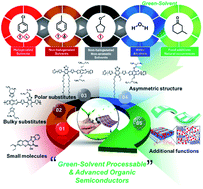Green-solvent-processable organic semiconductors and future directions for advanced organic electronics
Abstract
In recent decades, organic semiconductors (OSCs), which are lightweight, flexible, and have low processing costs, have enabled significant progress in terms of efficiency in the field of organic electronics [e.g., as active materials in organic photovoltaics (OPVs), hole-transporting materials (HTMs) in perovskite solar cells (PSCs), and semiconducting materials in organic thin-film transistors (OTFTs)]. However, most OSCs are currently being processed in halogenated toxic solvents, which creates conditions that are hazardous to the human body and the environment. Accordingly, for large-area fabrication and commercialization, OSCs must be developed to show high solubility in environmentally friendly and non-harmful solvents as well as high performance. This review considers environmentally benign solvents and potential approaches for increasing the solubility of OSCs in relation to Hansen solubility parameters (HSPs) and molecular design. It also provides guidelines regarding molecular design for advanced OSCs possessing additional functions, sustaining green-solvent processability, and superior efficiency. We believe that these efforts toward an environmentally benign process will contribute to the development and commercialization of organic electronics and shed light on future directions for OSC research in relation to industry, the environment, and human life.

- This article is part of the themed collection: Journal of Materials Chemistry A Recent Review Articles


 Please wait while we load your content...
Please wait while we load your content...